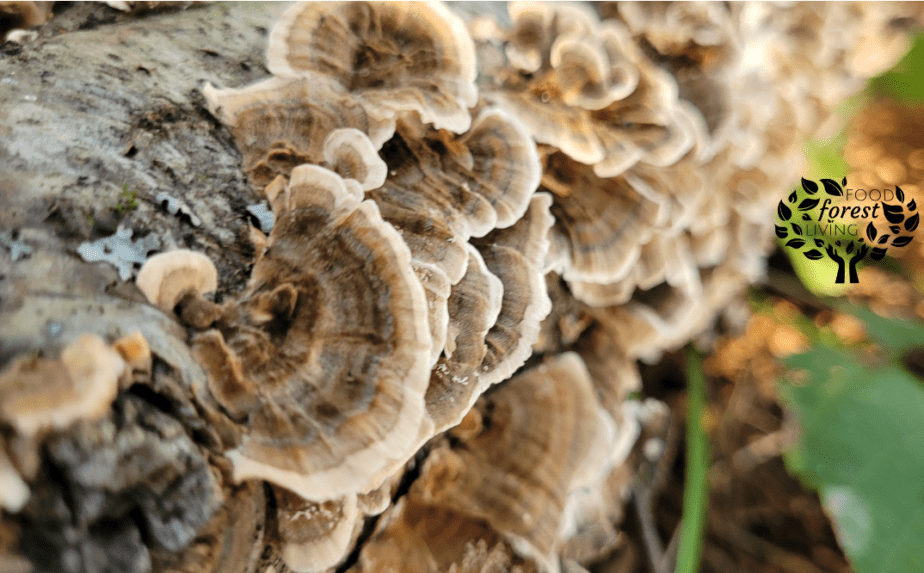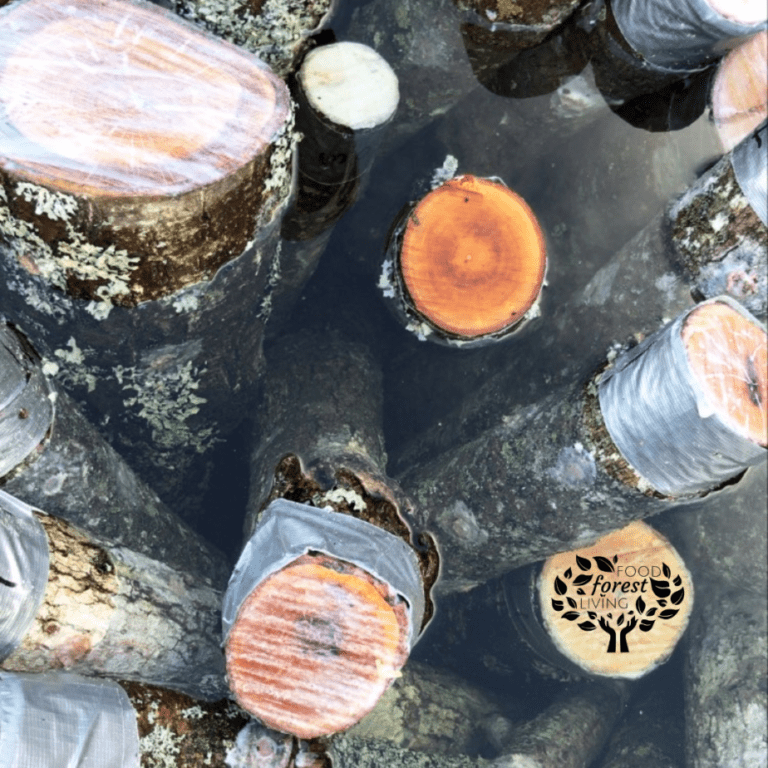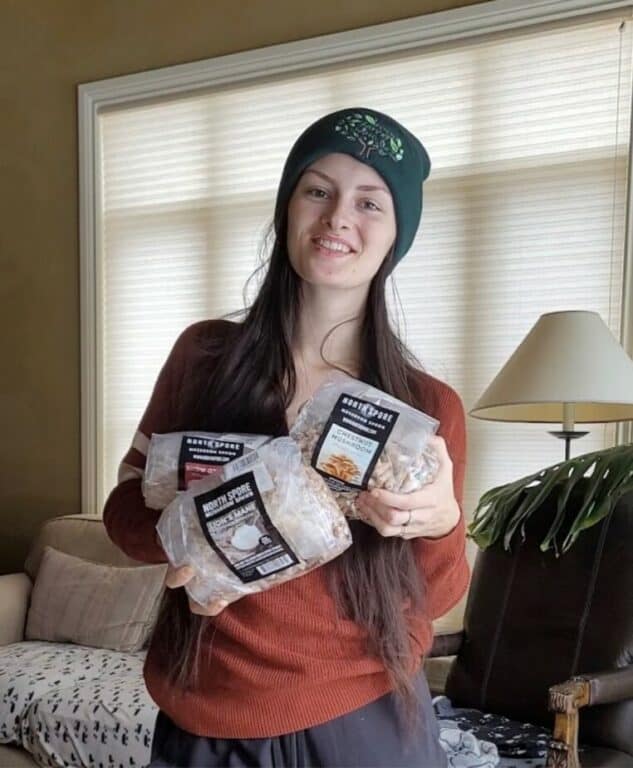This post may contain affiliate links. If you use these links to buy something we may earn a commission. Thanks.
Mushroom logs make it easy to identify edible mushrooms in your food forest. With enough time, the fungi layer of a food forest will happen on its own, but why not install some edible mushrooms on logs that you’ll be confident enough to eat?
A mushroom log is a fresh-cut manageable-sized log that gets inoculated to produce edible and medicinal mushrooms. You can order wooden dowel pins that arrive colonized with mycelium of the desired mushroom type. Inserting the plugs into the log provides long-term food for years of fruiting.
Several types of mushrooms can be grown on logs and some species are easier then others.
See: 9 Best Mushrooms to Grow on Logs (From Easy to Hard)
Below are essential details on how mushroom logs work so you can see what you’re in for before committing to making a mushroom log.
What you’re also going to want to know before starting your mushroom log journey is What it Costs to Grow Mushrooms (Indoor vs Outdoor).

How does a mushroom log work?
The mushroom world is filled with mystery but the way mushroom logs work is quite simple.
After injecting the log with plugs, the mycelium will populate the wood, break it down, and convert it to humus. The mushrooms we eat are the fruiting body of the mycelium. As the mycelium feeds on the log, it will fruit when the conditions are ideal until it’s entirely broken down.
You’ll need a few tools to insert the plugs, space to work, and some patience once they’re plugged and sealed.
After plugging your mushroom logs, colonization takes time before producing fruit.
How do you speed up mushroom fruiting?
Most things that produce for a long time take a long time before they produce, such as trees! Mushroom logs are the same. Like you can choose a tree that fruits faster, the speed of mushroom fruiting can also be manipulated in two ways.
Ideal conditions will speed up fruiting in any mushroom log. Small mushroom logs colonize faster than large logs, meaning they will fruit faster. Small logs expire quicker than big logs, meaning large logs will fruit for a long time but take longer before they first fruit.
I suggest inoculating a mix of small, medium, and large logs to enjoy the best of both worlds.
With an average mix of log sizes, you’ll be waiting between 6 months and 2 years for mushrooms. A minimum of one year for colonization is typical for logs. But truly small logs and softer hardwoods may colonize quicker which also means they’ll expire quickly too.
What is a flush of mushrooms?
A flush is a set of mushrooms that emerge when conditions are suitable. Mushroom logs fruit in “flushes” rather than constantly or continuously. 2-5 flushes per year are typical for mushroom logs and the range depends on the length and temper of any given season.
For cold climates with short growing seasons, 2 flushes per year are usual. One in spring and one in fall. Sometimes 2 or 3 flushes during a prolonged ideal period can happen as well. Generosity is always a possibility.
What triggers mushroom fruiting?
Once colonized, logs produce a flush when conditions meet their requirements. When growing mushrooms outdoors you’ll have partial control over triggering fruit.
Cool and moist weather conditions trigger mushroom fruiting naturally. To trigger mushroom fruiting manually; “shock” the logs by soaking them for 12-24 hours. Outdoor mushroom logs are reliant on temperature swings. Particular temperatures and moisture levels determine ideal conditions for fruit.
Fruit can’t be triggered or forced until the log has been colonized first.

We have had successful mushroom logs even without shocking them. Shocking logs quickly becomes a heavy job but isn’t so bad with a proper routine.
If you can’t around to shocking them, it isn’t the end of the world and you’ll most likely still end up with fruit if they have enough moisture.
Shocking our logs on rotation, in season, with an 8-week (minimum) interval has yielded us mushrooms more consistently.
How long does it take to colonize a mushroom log?
The colonization period of a mushroom log is like planting a young tree and waiting for it to fruit. The good news is, mushroom logs take a shorter time to colonize than trees take to fruit.
It takes between 6-24 months for a mushroom log to colonize and begin fruiting. Mushroom type, log size, and conditions will affect the rate of colonization.
Turkey tail, for example, can colonize rather quickly because it is an aggressive strain of mushroom. If you inoculate small logs with turkey tail and provide optimal conditions you’ll be making medicinal mushroom tea real quick.

This article was originally published on foodforestliving.com. If it is now published on any other site, it was done without permission from the copyright owner.
As I said before, the smaller the log the quicker it will expire. Small logs literally have less food mass than larger logs; therefore the mushrooms consume it faster.
What does it mean to inoculate a log?
To get the desired mushroom from your logs; you need to inoculate them!
Inoculating a log is to introduce the mycelium of the desired mushroom strain into a source of fresh food. This is done through plug spawn.
Plug spawn is a bag of dowel pins that have been colonized by a specific mushroom strain. The dowel pins are kept in the fridge to stay dormant until you are ready to inject them into logs where they will have plenty of food to fruit for years.
See: How long does it take to make and inoculate mushroom logs?
What time of year do you inoculate mushroom logs?
Mushroom logs are a seasonal activity and should be harvested and inoculated during certain periods of time for the best outcome. The best wood for mushroom logs comes from a tree harvested during dormancy for a few reasons.
While trees are dormant, the sap resides in the root system and the competition of wild mushrooms is halted at the same time. Anytime during winter is the ideal time to harvest your mushroom logs. Ideally, you’d inoculate your logs within 2-3 weeks of harvest.
Early spring, when the temperatures average at least 50 °F is the ideal time to inoculate fresh or stored mushroom logs. All mycelium begins to grow and search for new food to take hold. Early winter-cut logs are best plugged sooner than later so your logs don’t dry out too much.
You’ll need to keep any early-winter inoculated logs at a reasonable temperature so they can colonize the log. Do not put freshly plugged logs outside in freezing temperatures. Watering your logs will be crucial during this time as they won’t receive rain or morning dew as they would outdoors
You can make and cut mushroom logs any time of year.
However, harvesting fresh wood when the trees are still dormant and not full of sap is ideal. Tree sap has antifungal properties that hinder colonization—similar to how human blood keeps us alive, healthy, and resilient.
Cutting your wood and promptly inoculating your logs within a 2-3 week period—during early spring, before budding begins—will minimize the risk of competition from other spores. Allowing fresh-cut logs to sit for a short period before plugging them allows the sap to drain out.
Can you inoculate logs in winter?
Like trees, mycelium is dormant during the winter cold—growth rests, along with everything else. An advantage we have over the seasonal comatose; is living in controlled environments that aren’t cold.
You can inoculate mushroom logs in winter by housing them indoors until outdoor temperatures are appropriate. Trees are ideally cut while dormant in winter, anyway. Plugging logs indoors as a head start to spring means the desired mycelium can take over without competition.
Maybe you don’t have indoor space to house plugged logs before growth-stimulating temperatures. Does this mean you should go ahead and inoculate fresh logs in freezing temperatures? or store logs until warmer weather?
Store your logs until warmer weather to innoculate them with plugs. To safely store fresh cut logs outside in winter, elevate them off the ground, wax the cut ends, and drape them with evergreen limbs to retain moisture. The snow melts and moistens your logs in spring, readying them for plugs.
Putting plugs in frozen logs is like starting any perennial seed indoors, and putting it outside in the middle of winter. They will die without a full season to begin life and prepare for harsh conditions.
Can you inoculate mushroom logs in the fall?
With a headstart on the season, you might just end up with mushrooms by spring! Or at least next fall.
You can inoculate mushroom logs in fall up to at least a month before frost. Fungus is very active in fall, so it’s vital to plug the wood as soon as fresh-cut trees are no longer “green”. Allowing a month before frost will help them to establish before they go dormant in freezing temperatures.
Choose to cut fresh trees that have changed color or lost leaves.
The longer you wait between cutting a fresh tree and plugging its logs, the more competition your gourmet mushrooms will have to defy.
Can you inoculate mushroom logs in the summer?
In summer, trees are thriving with life, and it’s not exactly the best time to cut wood. However, it’s understandable you might end up with several downed trees after a tornado— as we had.

Unfortunately, like most tornadoes, it was our healthiest, most lush trees that got twisted and thrown down. Fortunately, healthy fresh wood will fit the bill when it comes to planting your mushroom plugs.
Don’t go out of your way to cut wood for mushroom logs in summer. However, if you have freshly felled trees and an overstock of firewood, you can make mushroom logs in summer with success.
For summer inoculation, allow the sap to run and wait until the leaves of the cut tree die back before plugging its logs.
We prefer to inoculate mushroom logs in early spring and have done so with nearly all of our logs. Timing for optimal conditions minimizes complications.
Can you inoculate old logs?
With busy lives, time slips away every so often. If you know you might not be able to get to plugging your logs within 1-2 weeks, there are a couple of things you can do.
You can inoculate logs between the age of 1 week and 4 months. The longer logs age, the more occupied by other fungi they will be. If you must set logs aside for several months before inoculating them, put them in a dry area. Fungi don’t grow well in a dry setting. Soak them when ready to use.
In winter, most life is dormant. If you must make logs wait excessive periods of time, holding off over winter is less critical. The worst time to let fresh-cut logs sit is in spring and fall.

Up next:
- Why Grow Mushrooms at Home? 8 Practical Motives
- How To Care for Mushroom Logs (Everything You Need to Know)
Recent Posts
There’s no shortage of full-sun ground covers for zone 4 climates! Each plant in this list can withstand the frigid temperatures and also enjoy the hot sun in summer. Full sun means that a plant...
There's no shortage of full sun ground covers, not even in zone 3! Zone 3 climates offer hot but short-lived summers and very cold winters. So each plant in this list can withstand the frigid...
